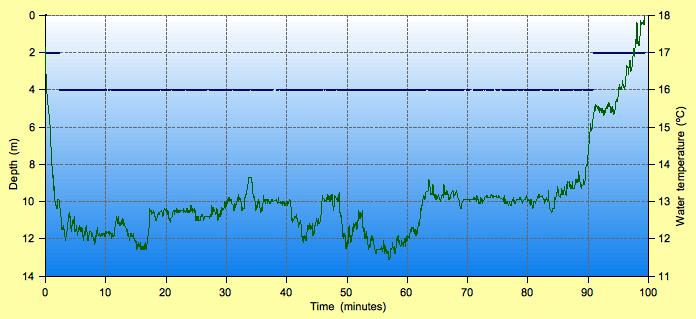Dive Details
Location
Date
Thursday 2 August 2018
Time
10:20am - 11:59am
Details
Today's dive, #2 of my attempt to dive 6 times in 5 days, was at The Monument, and Mike joined me. The forecast today was much the same as yesterday so we knew it would be calm. We'd be getting into the water around the same time as yesterday but the tide would lower as high tide was around 40 minutes later.
We got in at the protected area around a third of the way to The Steps and waded out. The water level was high enough for us to put our fins on quite early and we surface swam to the drop off. We descended and swam to the sand line. I spotted a crested horn shark on the way. At the sand line the visibility was 5 metres or so and there was a gentle current. The water temperature was around 16°C. We turned left and headed towards Sutherland Point.
We swam past Block Rock and on to the wall. At the start of the rock where "Ginger", the female pot-bellied seahorse, has been I spotted one of the dwarf lionfish in the orange finger sponge. Along the rock I looked in the sea tulips for "Ginger" but couldn't see her. I swam around and over the rock. I then spotted her tail wrapped a red chimney sponge. I took some photographs and pointed her out to Mike.
While Mike was photographing "Ginger", I dropped down to the sand to look for the juvenile weedy seadragon. I looked all around in the kelp but was not able to find it. When Mike caught up we swam up over the wall to the rock where the pygmy pipehorses I found last Friday are. After a bit of searching I found the male (IL2018072701) on top of the rock. The rock was covered in snot algae and there was a lot of algae around the pygmy pipehorse. I tried to clear some away. While I was looking for the female, Mike spotted a small Nembrotha purpureolineata nudibranch near the top of the wall. I showed Mike the pygmy pipehorse and went looking for the female again. I finally found the female (IL2018072702) on the lower side of the rock hidden near the white honeycomb sponge. She was covered in algae. I cleared away as much as I could.
We swam along the reef past Slope Rock and on to the slope below Seahorse Rock. I looked for the female White's seahorse who is normally in or near the orange finger sponge but I could not find her. I looked around the area but she did not seem to be there. We headed up around Seahorse Rock and I found the small Nembrotha sp. nudibranch that has been there for some time. I then headed back down the slope to look for the seahorse again. I removed some algae from around the red chimney sponge behind the orange finger sponge and found her there.
We continued along the reef past Split Rock and on to the area which has been good for red-fingered anglerfish. I swam up to the rock with the gap below it and found the large grey red-fingered anglerfish there. I pointed it out to Mike.
We swam along the wall and down to the sand. On the last rock I found the Volva volva cowrie and pointed it out to Mike.
We headed along the reef to the point and then swam up the reef towards the big rock with Carijoa. On the way up I spotted an eastern frogfish in a crevice.
On the big rock with Carijoa I spotted the large orange red-fingered anglerfish. It was in much the same spot it had been on Saturday when Robert found it. I showed it to Mike before swimming south-east to the rock where the bright orange red-fingered anglerfish has been. It was pretty much in the same spot it has been over the last few months.
We headed west along the east-west wall to the pygmy pipehorses. I found the gold and white female (IL2018053101) almost immediately. I looked for a while and found one of the yellow males (IL2018071401) and then the other yellow male (IL2018071402). I looked around for the other female but could not find her.
We headed east again to the large orange red-fingered anglerfish and then south-east to the bright orange one. We continued south-east and I spotted the other orange red-fingered anglerfish.
We continued south-east along the shallow wall towards the exit. We ascended to 5 metres and started our safety stop. We got out in the little bay to the south east of the rocks on the point.
Buddy
Mike Scotland
Seas
Calm
Visibility
3 to 8 metres
Duration
98 minutes
Maximum depth
13.1 m
Average depth
9.9 m
Water temperature
16°C
Dive Profile from Garmin Descent Mk1

Tides at Botany Bay AEST
Note that tides at dive site may vary from above location.
Low
5:44am
0.45m
High
11:55am
1.40m
Low
5:40pm
0.64m
High
11:50pm
1.54m